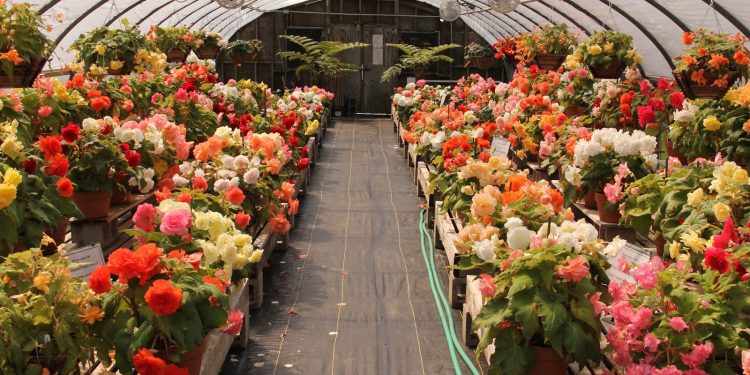Participants of the flower market after the introduction of new sanctions and the fall of the ruble are going through hard times. Up to 90 percent of cut and potted plants sold in Russia are imported. Now deliveries from abroad are carried out almost in full. Their decline can only occur if the borders are physically blocked. But this was not the case even during periods of the most severe coronavirus restrictions. But the cost of purchasing and delivering flowers, depending on the type, increased by 40-60 percent.
There is no shortage of flowers, but their prices have grown. It’s expensive to buy, but you can admire it for free.
Before the crisis, cut flower prices depended on the season, the availability of goods in nurseries ready for shipment and free seats on airlines that deliver cargo from Ecuador, Colombia, Kenya, Israel and the Netherlands. Now prices have been affected by both the high exchange rate and the physical shortage of quality flowers. Due to restrictions on payments through the SWIFT system and the inability to pay for goods through web stores using Visa and Mastercard, there were difficulties with paying for already shipped products. This resulted in a delay or disruption in deliveries.
On sale you can find flowers of hundreds of species and varieties, but for a general idea of \u200b\u200bprice dynamics, you can take statistics on the main types represented in Russia. For clarity, let’s compare wholesale prices for regular non-holiday deliveries until February 14 and March 8, 2022 and at the current moment. So, a rose with a stem height of 50 centimeters has risen in price from 82 rubles to 112, and a 60-centimeter one – from 94 to 125. The small-flowered chrysanthemum previously cost 84 rubles, now – 109; large-colored – 106 and 139 rubles, respectively. Gerbera in early February was sold for 102 rubles, now – for 144. Lily has risen in price from 275 to 342 rubles; alstroemeria – from 74 to 93; carnation – from 35 to 44.
This inevitably leads to an increase in retail prices. So, for example, for roses 50 centimeters long, the price tag has changed from 175 to 225 rubles apiece, for 60-centimeter ones – from 94 to 250. Small-flowered chrysanthemum cost 155 rubles, now it is sold at retail for 205; for large-flowered, these are 195 and 230 rubles, respectively. Gerbera rose in price from 185 to 210 rubles, lily – from 425 to 635 rubles, alstroemeria – from 160 to 180 rubles, carnation – from 75 to 90.
Nothing affected the supply of flowers from countries that were in the unmanned zone. Suppliers from Ecuador, Colombia, Kenya, Israel and a number of other countries have not terminated current contracts with Russian buyers and have not introduced restrictions against the Russian Federation. Therefore, nothing prevents them from sending flowers here. Planes from these countries follow to the Netherlands, where the cargo is consolidated with goods from local manufacturers, and then sent by road to Russia. Due to the increased volume of cargo transportation at the border, delays sometimes occur, but there are no global problems. Difficulties arose only for those companies that used direct flights from the Netherlands to the Russian Federation. We have to switch from air transport to land transport, which so far goes through European countries without restrictions. New flower delivery routes are being developed, for example, through Kazakhstan: a plane flies from Holland to Almaty or Astana, and then the flowers go to Russia along highways.
Suppliers from Ecuador, Colombia, Kenya, Israel and a number of other countries have not terminated contracts with Russian buyers
Refusals to continue work on the part of European partners are rare. The vast majority is set to continue cooperation. However, it is limited by obstacles to making payments due to sanctions. Unfortunately, alternative banking systems such as Mir and UnionPay are not yet supported in web stores.
Flower suppliers began to give goods only with 100% payment, some began to take prepayment, banks began to close credit limits. The conditions for the return of defective products to suppliers have become tougher (and somewhere this possibility has completely disappeared).
The wave of flower shop closures today is more massive than in previous years. Some owners made the decision before the holidays. In the flower business, some outlets close every year. Usually new entrepreneurs came to the vacant place, but now it has become much more difficult for businesses to find sources of financing. The great uncertainty in the country’s economy hinders both the current players in the flower market and the beginners. It is very difficult to predict something and make meaningful management decisions. The risks of failures and bankruptcies have increased significantly. At the same time, we should not forget that the departure of weak players is a normal process.
Before businessmen who still remain in the Russian flower market, a difficult question arises: how not to lose revenue. On the one hand, due to rising inflation, purchasing power is decreasing, and on the other hand, the number of retail offers is decreasing.
The experience of the crises of 2008, 2014 and 2020 showed that a Russian buyer buys flowers regardless of the economic situation, since this is a universal and beautiful way of congratulations. The size of the average check will not change and will be approximately 2-2.5 thousand rubles per bouquet. But the number of flowers in it will decrease due to the increased cost of flowers. In other words, the physical volume of sales will decrease. And this will increase the current costs of both wholesale and retail companies.
But those who can stay on the market for two to three months will have good prospects: the number of flower shops will decrease, and buyers will be forced to shop at outlets that could survive.
How to help Ural clothing designers promote their products
The process of import substitution of flowers, as well as products of other industries, began in 2014 – after another devaluation and the first wave of Western sanctions. Prior to that, domestic producers worked mainly in the Krasnodar Territory and grew tulips by March 8. Then in the Moscow and Novosibirsk regions, as well as in a number of other regions, they began to actively build greenhouses for roses, chrysanthemums and alstroemerias. Imported technologies (sprouts and fertilizers) were used, agronomists from abroad were invited. At the first stages, the quality of the flower was significantly worse than that of analogues grown in Ecuador, Colombia or the Netherlands. But now domestic products do not differ from imported ones, but they are cheaper by 20-30 percent.
The events of recent weeks have helped Russian flower growers to take an even more advantageous position in the market. Demand for their product has grown significantly, which will allow nurseries to increase production and reduce delivery times, and reduce transport costs for flower companies.
The Government of the Russian Federation provided grants and preferential loans for the construction of new greenhouses for flowers. This, no doubt, will help market players and protect them from being hit in the event of new sanctions against our economy.










